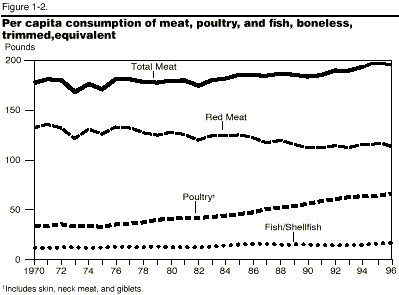Animals Killed for Meat
Per Capita Animals
Killed Each Year
(that is, number of animals killed by Americans who eat meat)
This table is an excertpt from a graph on page 8 of the U.S. Department of Agriculture's 1997 Agriculture Fact Book:
Major foods: U.S. per capita consumption
|
Food |
|
|
|
|
Pounds |
|||
|
Beef |
|
|
|
|
Pork |
|
|
|
|
Veal |
|
|
|
|
Lamb and mutton |
|
|
|
|
Chicken |
|
|
|
|
Turkey |
|
|
|
|
Fish and shellfish |
|
|
|
And these numbers are from USDA statistics (see also, alt. source):
- an average steer produces about 710 lbs of meat.
- an average calf produces about 210 lbs of meat.
- an average hog produces about 186 lbs of meat.
- an average sheep produces about 64 lbs of meat.
- Numbers on poultry are difficult to find, but an average
broiler chicken produces about 4.8
lbs of meat and an average turkey produces around
23
lbs of meat.
A different USDA report states that young chickens produce 4.68 lbs per bird, and mature chickens produce 5.11 lbs per bird. It also states that turkeys average 24 lbs per bird. Use these (the bold), not the above.
Combining those numbers, we find this many animals being
killed for each American:
|
"Food" |
1995 |
quantity of animals per year |
quantity of animals in 60 years |
|
|
|
|
|
|
Beef |
|
|
|
|
Pork |
|
|
|
|
Veal |
|
|
|
|
Lamb and mutton |
|
|
|
|
Chicken |
|
|
|
|
Turkey |
|
|
|
|
Fish and shellfish |
|
|
|
|
Total |
10.5 birds and mammals per year, plus 15 lbs of fish and shellfish. |
more than 22 mammals, more than 608 birds, and about 900 lbs of fish and shellfish. |
Incidentially, the U.S. Department of Agriculture's 1997 Agriculture Fact Book shows this graph on page 2:

![]()
Total Number of Animals Killed Each Year
A report by the U.S. Department of Agriculture states: "U.S. total cattle and beef slaughter in 1997, while remaining relatively high at 37.6 million head, shows a modest decline from the peak liquidation level of 1996."
When looking at world numbers, their tables of selected country statistics project for 1998:
- 232,000,000 cattle slaughtered.
- 1,100,000,000 hogs slaughtered. Yes, that’s 1.1 billion pigs. In one year. Some of the smartest creatures on Earth.
- 470,290,000 sheep and goats slaughtered.
That's more than 1.6 billion large animals slaughtered in one year. Nearly one billion of those are hogs, considered to be among the most intelligent of animals.
For poultry, the Foreign Agriculture Service states that 52,745,000 metric tons of poultry meat were "produced" in 1997. By my rough estimates, that comes to 40,614,000 metric tons of chicken and 12,131,000 metric tons of turkey. That means 89,537,624,000 pounds of chicken and 26,744,002,000 pounds of turkey. Given the estimates of 5.11 pounds of "meat" from a chicken and 24 from a turkey, that means:
- 17,522,040,000 chickens slaughtered
- 1,114,333,000 turkeys slaughtered.
Yeah... that's more than 18 billion birds killed for our pleasure and convenience. Since they only gave gross figures, there's a lot of calculation in there, but my estimates are conservative... In any event it is many billions of birds.
The fish and "seafood" are even harder to calculate, but the numbers are staggering.
Here's another juicy tidbit from the USDA, on page 4 of its 1997 Agriculture Fact Book:
- We Are a Nation of Meat Eaters--Now More Than Ever. In 1996, total meat consumption (red meat, poultry, and fish) was 191 pounds (boneless, trimmed equivalent) per person, only 2 pounds below 1994's record high and 12 pounds above the 1980-84 annual average. Half-pound hamburgers and "value-priced" buckets of fried chicken draw slews of customers to foodservice outlets. Rotisserie chicken and Buffalo wings have become so popular that they have made inroads across the country, even in pizzarias. Americans love to barbecue meat on outdoor grills--boosting per capita consumption in warm months--and, increasingly, on indoor grills year round. A host of new lean-meat products cater to saturated-fat-wary consumers. Seasoned, ready-to-cook meats available in the fresh and frozen food cases and cooked meats in the self-serve and service delicatessens appeal to time-crunched consumers.
Copyright © 1998-2007 by Ed Pastore. All rights reserved. Excerpts from this document may be quoted with proper reference to the URL, the author, and the modification date listed below.